A shower pan is just as crucial to a bathroom as the foundation for a house, but it’s also one of the most frequently disregarded bathroom necessities that call for consideration is a shower pan. A shower pan should be tightly packed and must not crack, allowing water to seep or mold to grow into the subfloor.
By ensuring that bathroom tiles stay dry and guarding the shower floor against leaks and mold, installing a shower pan helps to prevent mishaps. This blog will discuss what is a shower pan and what are the types of shower pans.
What Is A Shower Pan
A shower pan stands between the flooring and the shower as a barrier. Shower pans are waterproof inserts with a slight slope that are installed on top of a shower base to prevent leaks and direct water toward the drain. It serves as a funnel that guides the water from the shower to the drain, which is vital to its functionality.
Shower Pan Vs. Shower Base
Shower pan and shower base are terms that are frequently used identically. The water is directed toward the drain by a shower base and a shower pan. The position is the main distinction between the shower base and the pan.
The shower base, located below the pan and a part of the bath foundation, serves as the shower’s actual floor. Typically, waterproof cement mortar is used to create shower bases.
Types Of Shower Pans By Material
The materials used to make shower pans come in various sizes, shapes, and colors and have varying properties, strengths, and aesthetics. Choosing a shower pan can be made much simpler by understanding the shower pan materials‘ pros and cons.

1. Solid Surface Shower Pans
Solid surface shower pans are currently experiencing a resurgence in popularity. Solid surface is the best shower pan material. It is a flexible, hygienic, and fashionable material that merits special consideration. The solid surface material can be textured, so it’s secure and cozy for everyday showers.
Shower pans by KKR are created using solid surface material that has all the qualities: from good looks to unmatchable strength. One of the main advantages of selecting a KKR solid surface shower pan is how simple it is to install, which can drastically save labor costs.
A KKR solid surface shower pan will finish the bath look for many years to come, thanks to the minimal maintenance required and the adaptable and aesthetically pleasing designs and textures.
As they can be simply refinished if necessary and hold up to years of use, homeowners get even more worth for their initial investment. Businesses should include this in their best shower pans catalog to attract more customers.
Pros:
- A variety of design options
- Less time is needed for the installation
- No requirement to waterproof
- Compared to natural stone or tile, it is simpler to clean
Cons:
- These can be heavy
- If exposed directly to greater temperatures, they may be vulnerable to heat-related damage
2. Tile Shower Pans
The cost of installation and upkeep make tile shower pans, despite their popularity, one of the priciest shower pan materials. Due to their high initial cost and ongoing maintenance, these are typically considered expensive options. They work effectively in regions with heavy traffic and can withstand wear and tear over time.
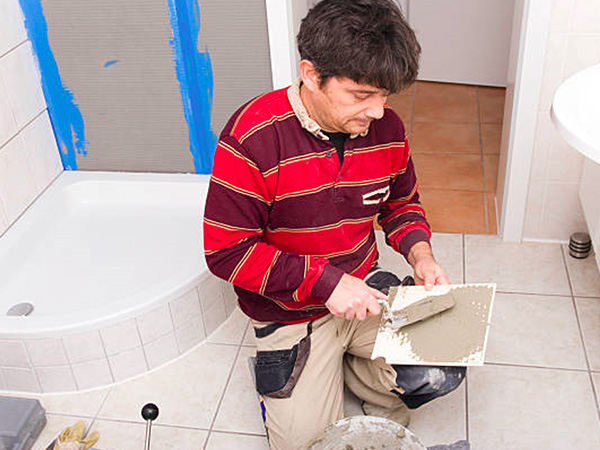
Pros:
- Incredibly sturdy
- Easy to keep clean
- A limitless selection of colors and trends is available
Cons:
- An expensive shower pan material
- Extremely challenging and time-consuming to install
- On the grout between the tiles, they might potentially develop stains
- Due to water leaks, tiled shower pans frequently require shower repairs
3. Cultured Stone Shower Pans
Shower pans with cultured stone finishes are constructed from resin and ground stone. These pans are typically made of marble, granite, or limestone. This pan’s outstanding waterproof safety against leaks, scrapes, and degradation is made possible by the sprayed-on gel coating. Even though cultured stone comes in various sizes and shapes, it is rather pricey.
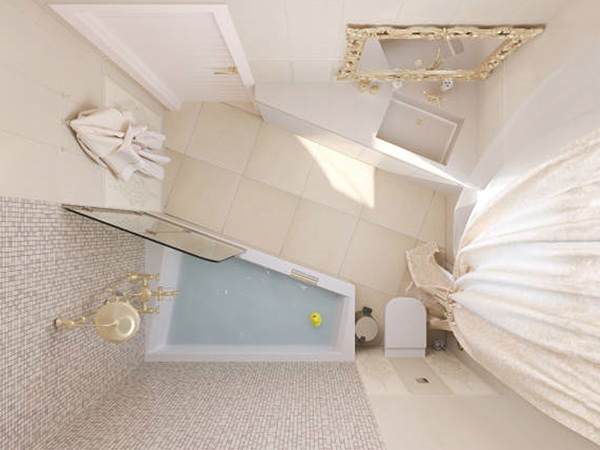
Pros:
- The material is stain and chemical resistant
- It is more hygienic and easier to clean
- Making changes to the size and shape is significantly easier
- It has a highly upscale appearance
Cons:
- It is expensive
- Compared to typical stone, the outer layer can chip pretty easily
- Poor upkeep might result in buildup or stains that are difficult to remove
4. Porcelain Shower Pans
Another excellent option is a porcelain shower pan. Because porcelain is so robust, it is a very long-lasting and durable material for a shower pan. Because of their substantial weight, these pans are known to remain stable for a few years before needing to be replaced. Although this kind of shower pan can be more expensive, its durability makes up for it.
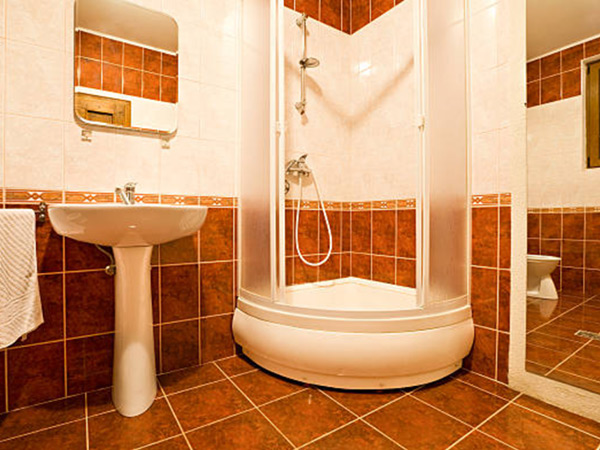
Pros:
- Their sizes and shapes are diverse
- It is one of the shower pan types that are easiest to maintain
Cons:
- More money may be spent on installation
- Compared to some natural stones, porcelain has a lower hardness
- Scratches or chips might be noticeable
5. Fiberglass Shower Pans
A fiberglass shower pan is one of the least expensive shower pan types that are still functional. Plastic-based products include fiberglass material and acrylic. Because they are simple to produce, extremely waterproof, and low maintenance, they are frequently used for shower products. However, only a few sizes are available because they are manufactured goods.
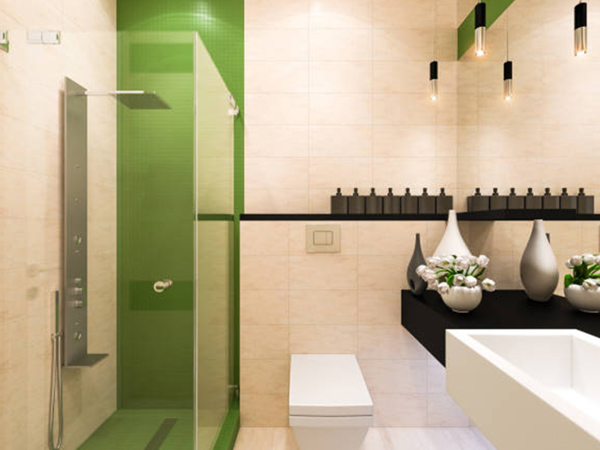
Pros:
- Little upkeep is required
- Installation is simple and fast
- It is capable of being durable and has a minimal likelihood of breaking or cracking
- Affordable
Cons:
- It isn’t visually appealing
- It is not customizable
- Only available in specific sizes
- There are not many color possibilities
- It is sensitive to very high temperatures
6. Marble Shower Pans
Shower pans made of marble are just stunning; that much is true. The sleek and contemporary appearance of real marble is unmatched. For a bathroom cubicle that looks opulent, shower pans are offered in various designs, forms, and colors.
As marble is a natural stone, it is highly durable and resistant to breaking. Marble shower pans are naturally resilient and can be made to fit any size so that they can last for many years with little upkeep.

Pros:
- It is visually appealing
- Extremely durable
- It has many different color schemes and shape possibilities
Cons:
- Prone to stains
- It requires high maintenance
- It is porous
- It is not resistant to abrasive chemical cleaning agents
7. Concrete Shower Pans
Purchasing a concrete shower pan is equivalent to making a lifetime commitment because it will remain in place. They are often offered in white, gray, and black. These pans are incredibly strong and can be altered to fit any shower size. Most of the time, this shower pan material is chip-resistant, easy to maintain, and clean.
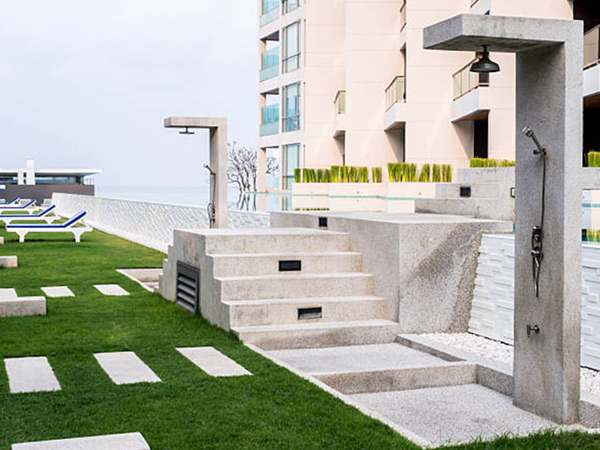
Pros:
- Water resistant
- Affordable pricing
- It’s renowned for being durable
- It is simple to maintain and clean
Cons:
- It can host germs when it’s moist
- An excellent surface finish is required
- The pan could be penetrated by moisture from the surface
8. Cast Iron Shower Pans
Cast iron, one of the most common materials, can also make shower pans. It is not only solid but also completely stable due to its dense composition. A homeowner might consider cast iron if they want a durable shower pan that will last for many years. Cast-iron shower pans materials have a lot of weight and a complicated installation method, which is its major drawback.
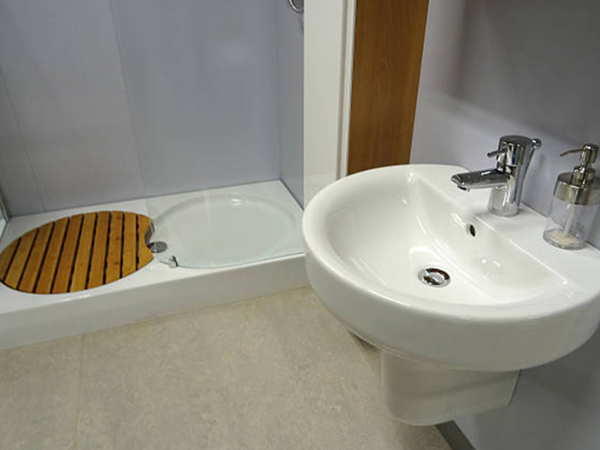
Pros:
- Sturdy, not prone to readily chipping or cracking
- It is scratch-resistant
- The coating offers defense against the majority of harsh chemical cleaning agents
- Simple to maintain and clean
Cons:
- One of the priciest materials available
- It might be slippery
- There are only a few options for colors
- Rust can form in places where the enamel coating has been lost
- Super heavy
9. Stainless Steel Shower Pans
One of the most rigid kinds of shower pans is those made of stainless steel. They can be incorporated into traditional and contemporary shower designs and are simple to install. The shower pan will remain sturdy and serve long because stainless steel is exceptionally corrosion-resistant.
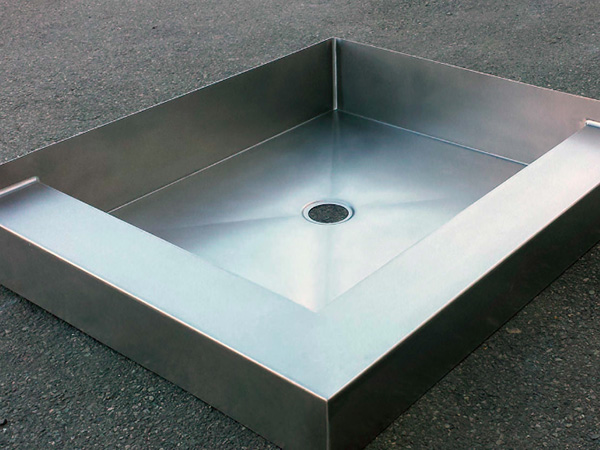
Pros:
- It doesn’t leak
- Choose from a variety of finishes to customize the shower pan
- They can withstand the majority of cleaning agents
- Installing them is comparatively simple and affordable
Cons:
- It can be expensive
- No color options
How to Choose the Best Shower Pans for Your Project
Each of the shower pans, as mentioned earlier, has certain benefits. Based on the demands and tastes of the homeowner, one is likely to suit a bathroom the best. These are some factors to think about while selecting the best shower pan.
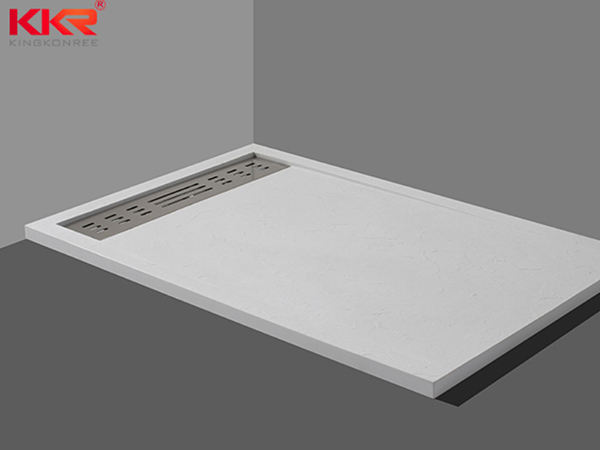
Shapes
A shower pan’s shape will depend on the size of the bathroom. Larger rectangular shower pans work well in larger bathrooms, while space-saving designs like a round shower pan are more suited for smaller bathrooms.
It should fit into the available bathroom area and not take up so much room that it obstructs other bathroom furniture and fittings. Determining the proper shape of the shower pan should therefore be a top concern.
Thresholds
Shower pans come in various threshold kinds, just like they do in sizes and forms, to satisfy client preferences and code requirements.
- Residents can enter the shower without any chance of tripping or falling, thanks to barrier-free shower pans.
- Beveled thresholds make it simple for wheelchair users to access them and guarantee ADA code compliance.
- Curbed thresholds can be anywhere from 12 inches and 6 inches in height.
- For barrier-free showers, impermanent thresholds are detachable curb that is a perfect choice for multi-family houses or those thinking about aging-in-place design.
Drain Locations
It is not unexpected that the drain, regardless of the shower style, is one of the most crucial parts of the setup when it comes to shower pans. Any installation or replacement of a shower pan will need working around the existing plumbing systems.
Before purchasing, homeowners must understand where the shower drain is located. To ensure proper water drainage, the drain holes must align with the shower’s design. Three distinct drain options are available to homeowners: an edge drain on the right or left side of the shower pans.
Cost Of Shower Pans
There are shower pans available for every price range, depending on the size and material you pick. Finding the shower pan that best matches your target audience requires considering elements like sustainability, mechanisms to keep moisture unchanged from repeated usage, non-slip qualities, aesthetics, durability and the quality of shower pans materials.
Solid surface shower pan is the best material for a shower pan as it gives the value for money. It is affordable yet comes with features of a high-end premium material.
How To Install A Shower Pan
This part will guide you through the process of installing a shower pan step-by-step. From preparing the area to setting the pan, it will cover everything you need to know to complete the job successfully.
Follow these steps to install a shower pan:
- After removing the old pan, affix a waterproof pan liner. When you start, make sure the surface is clean and clear of dust.
- To make the new pan flat, dry fit it. On either side of the pan, place two levelers. To level the pan, if one edge is lower than the other, apply shims and tack them into place.
- To keep the drain attached to the pan, use a plumber’s putty.
- Apply a layer of the mortar mixture to the liner approximately an inch thick; it should not have a runny consistency. Keep it out of the drain hole.
- In the cement on the shower floor, set the new pan.
- Once the mortar dries, it will expand and hold the pan in its place.

Get Your Custom Shower Pans From KKR
All bathroom fixtures are guaranteed to be hygienic and long-lasting when purchased from reputable solid surface shower pan manufacturers like KKR. With the numerous models on offer, your company can draw clients from the markets you’ve selected.
KKR has over 23 years of industry experience and exported shower pans to over 107 countries.
To assist you in converting your concepts into workable strategies, KKR provides free consulting and expert guidance. You are given a product catalogue that features custom shower pans. With their limitless customizations, you can find your dream product that will be popular among your customers.
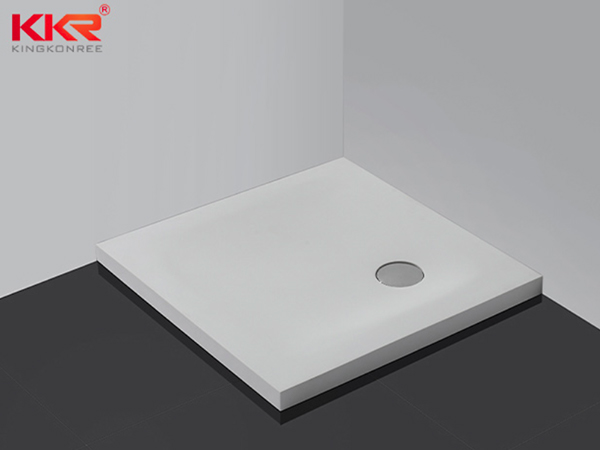
Nevertheless, the benefit of KKR becomes apparent when you put a KKR solid surface shower pan up against nearly any other. They save thousands in labor costs because they are quicker, simpler, and easier to set up and maintain. KKR shower pans are designed to last for many years.
Having a solid surface shower pan is a great choice. You can visit KKR’s website or contact them for the most outstanding collection of solid surface shower pans.
FAQs About Choosing from Types of Shower Pans
A shower pan can only occupy a tiny area of the shower and is simpler to install. Because a shower base is more specialized, installation is more difficult. They are usually built of cement or mortar, and they are frequently located beneath the shower pan.
The shower pan is a watertight obstruction. It is concealed beneath the floor of a shower. Any water that leaks through the grout and tiles will be directed to the drain by the pan.
Although there are many different styles and sizes, all standard shower pan sizes are the same. Shower pans come in sizes ranging from 32 x 32 inches to 60 inches, and they are often square or rectangular.
Shower pan installation or replacement typically costs between $800 and $2,500. The size, type, materials, functionality, labor, and foundation type all affect shower pan prices. The majority of shower pans are either mud-cast or tile-ready. The labor cost to install a shower pan ranges from $45 to $150 per hour, and it is generally handled by a qualified tiler or plumber.



